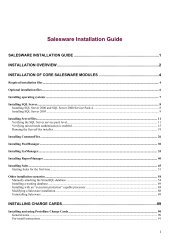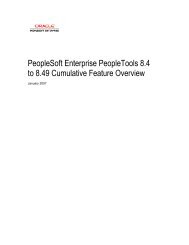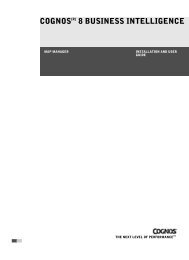Cognos ReportNetTM Installation and Configuration Guide
Cognos ReportNetTM Installation and Configuration Guide
Cognos ReportNetTM Installation and Configuration Guide
Create successful ePaper yourself
Turn your PDF publications into a flip-book with our unique Google optimized e-Paper software.
Appendix A: Manually Configuring ReportNet<br />
The console attached to the UNIX computer on which you are installing ReportNet may not<br />
support a Java-based graphical user interface. You must<br />
❑ manually change default configuration settings by editing the crnstartup.xml file, located in<br />
the crn_location/configuration directory<br />
❑ manually change language or currency support, or locale mapping by editing the<br />
crnlocale.xml file, located in the crn_location/configuration directory<br />
❑ apply the configuration <strong>and</strong> the locale settings to your computer by running <strong>Cognos</strong><br />
<strong>Configuration</strong> in silent mode<br />
For all installations, some configuration tasks are required so that ReportNet works in your<br />
environment. If you distribute ReportNet components across several computers, the order in<br />
which you configure <strong>and</strong> start the computers is important.<br />
Other configuration tasks are optional <strong>and</strong> depend on your reporting environment. You can<br />
change the default behavior of ReportNet by editing the crnstartup.xml file to change property<br />
values. You can also use sample files that enable ReportNet to use resources that already exist<br />
in your environment.<br />
Manually Change Default <strong>Configuration</strong> Settings<br />
If the console attached to your UNIX computer does not support a Java-based graphical user<br />
interface, you must edit the crnstartup.xml to configure ReportNet to work in your reporting<br />
environment.<br />
Before you edit the crnstartup.xml file, ensure that you<br />
• make a backup copy<br />
• create the content store on an available computer in your network (p. 19)<br />
• review the configuration requirements for your installation type (p. 33)<br />
If you want ReportNet to use a resource, such as an authentication provider that already exists<br />
in your environment, you can add a component to your configuration. You do this by copying the<br />
required XML code from the sample files into the crnstartup.xml file <strong>and</strong> then edit the values to<br />
suit your environment.<br />
Important: By default, the crnstartup.xml file is encoded using UTF-8. When you save the<br />
crnstartup.xml file, ensure that you change the encoding of your user locale to match the<br />
encoding used. The encoding of your user locale is set by your environment variables.<br />
When you edit the crnstartup.xml file, remember that XML is case-sensitive. Case is important<br />
in all uses of text, including element <strong>and</strong> attribute labels, elements <strong>and</strong> values.<br />
Steps<br />
1. Go to the crn_location/configuration directory.<br />
2. Open the crnstartup.xml file in an editor.<br />
3. Find the configuration setting you want to change by looking at the help <strong>and</strong> description<br />
comments that appear before the start tag of the elements.<br />
4. Change the value of the element to suit your environment.<br />
Tip: Use the type attribute to help you determine the data type for the configuration<br />
property.<br />
5. Repeat steps 3 to 4 until the configuration values are appropriate your environment<br />
6. Save <strong>and</strong> close the file<br />
<strong>Installation</strong> <strong>and</strong> <strong>Configuration</strong> <strong>Guide</strong> 103
















